Non woven geotextile fabric is a versatile and innovative material that is revolutionizing the field of civil engineering. Designed to enhance the stability and durability of construction projects, this fabric is specifically engineered to provide superior strength and protection. With its unique composition, non woven geotextile fabric offers excellent filtration, drainage, and separation properties, making it an indispensable component in a wide range of applications.
Whether it’s road construction, land reclamation, or erosion control, non woven geotextile fabric is the go-to solution for engineers and contractors seeking reliable and efficient materials. Its non-woven structure ensures exceptional resistance to tearing, puncture, and degradation, ensuring long-lasting performance and cost-effectiveness. Moreover, the fabric’s ability to provide efficient filtration helps prevent the clogging of drainage systems, thereby reducing maintenance costs and improving overall project efficiency.
The versatility of non woven geotextile fabric extends beyond its technical properties. With its lightweight and easy-to-handle nature, installation becomes a breeze, saving both time and labor costs. Additionally, its eco-friendly composition makes it a sustainable choice, aligning with the growing demand for environmentally conscious materials in the construction industry.
Discover the countless benefits and applications of non woven geotextile fabric and witness its transformative impact on your construction projects. Experience unmatched durability, improved drainage, and enhanced stability with this cutting-edge material, designed to withstand the most demanding conditions. Trust in the power of non woven geotextile fabric and elevate your construction endeavors to new heights.

What is Non Woven Geotextile Fabric?
Non woven geotextile fabric is a type of permeable textile material made from polypropylene or polyester fibers. It is commonly used in civil engineering and construction projects for its excellent filtration, separation, and reinforcement properties. Unlike traditional woven fabrics, non woven geotextiles are manufactured by bonding or needle-punching the fibers together, resulting in a fabric with a random and flexible structure.
The Benefits of Non Woven Geotextile Fabric
Non woven geotextile fabric offers numerous advantages that make it a popular choice in various applications:
1. Filtration:
One of the primary uses of non woven geotextile fabric is as a filtration material. Its porous structure allows water to pass through while retaining soil particles, preventing clogging and maintaining proper drainage. This is especially crucial in areas prone to erosion or where water flow needs to be controlled, such as highways, railways, and retaining walls.
2. Separation:
Non woven geotextiles are highly effective in separating different soil layers and preventing their intermixing. When used as a separator, the fabric acts as a barrier between dissimilar materials, such as soft subsoil and granular fill. This helps to maintain the stability and integrity of the construction, reducing the potential for settlement and deformation.
3. Reinforcement:
Another key benefit of non woven geotextile fabric is its ability to enhance the mechanical properties of soil. By adding tensile strength and improving load distribution, it reinforces the soil structure and increases its stability. This is particularly valuable in areas with weak soils or where additional support is required, such as under roadways, embankments, and landfill liners.
4. Erosion Control:
Non woven geotextiles play a vital role in erosion control by stabilizing slopes and preventing soil loss. When installed on embankments, hillsides, or riverbanks, they provide a protective layer that resists the erosive forces of wind and water. The fabric’s permeability also allows vegetation to grow through it, further strengthening the soil and promoting natural erosion control.
5. Environmental Sustainability:
Non woven geotextile fabric aligns well with sustainable development practices. It is recyclable and can be reused in other construction projects, reducing waste. Additionally, its use in erosion control and soil stabilization helps to protect the environment by preventing sedimentation in water bodies, preserving ecosystems, and minimizing the need for harmful chemical interventions.
Applications of Non Woven Geotextile Fabric
Given its versatility and wide range of benefits, non woven geotextile fabric finds application in various fields:
1. Road Construction:
Non woven geotextiles are commonly used in road construction projects. They are installed to improve the stability and longevity of roads by separating subsoil layers, preventing the migration of fine particles, and enhancing drainage. The fabric also helps to distribute loads evenly, reducing the occurrence of cracks and potholes.
2. Landfill Engineering:
Non woven geotextiles are integral to landfill engineering. They are used as liners to contain and prevent the contamination of underlying soils and groundwater by leachate. The fabric’s filtration property ensures proper drainage within the landfill while preventing the leaching of harmful substances into the environment.
3. Coastal Protection:
Non woven geotextiles are employed in coastal protection projects to mitigate erosion and stabilize shorelines. They are installed to create sand dune structures that act as natural barriers against wave action and storm surges. The fabric’s permeability allows water to escape while retaining the sand, reinforcing the dunes and safeguarding coastal areas.
4. Agricultural Applications:
Non woven geotextiles have proven valuable in various agricultural applications. They are used in erosion control on slopes, terraces, and embankments. The fabric helps to stabilize the soil, control water runoff, and improve crop yields. Additionally, it finds use in greenhouses and nurseries, providing a protective layer for plants and promoting healthy root development.
5. Drainage Systems:
Non woven geotextile fabric plays a crucial role in drainage systems. It is used as a filter layer around perforated pipes to prevent soil or debris from entering, ensuring the efficient flow of water. This application is commonly seen in subsurface drainage systems, septic fields, and agricultural drainage systems.
Conclusion
Non woven geotextile fabric is a highly versatile and beneficial material widely used in civil engineering, construction, and environmental projects. Its filtration, separation, reinforcement, erosion control, and sustainability properties make it an essential component in various applications. From road construction to landfill engineering and coastal protection, non woven geotextiles offer effective solutions for improving stability, preventing soil erosion, and promoting environmental sustainability.
Unveiling the Marvels of Non-Woven Geotextile Fabric
Video Source : I Am a Hardscaper
Non Woven Geotextile Fabric
Non Woven Geotextile Fabric
| Property | Description |
|---|---|
| Material | Non woven geotextile fabric is typically made from high-quality polypropylene or polyester fibers, ensuring excellent strength and durability. These materials offer resistance against biological and chemical degradation, making them ideal for various geotechnical applications. |
| Function | Non woven geotextile fabric acts as a versatile separator, filter, and stabilizer in civil engineering projects. It efficiently prevents the mixing of different soil layers, while allowing the passage of water, thus facilitating proper drainage. Moreover, it provides reinforcement to weak soils, enhancing their load-bearing capacity. |
| Permeability | One of the key attributes of non woven geotextile fabric is its high permeability. It allows water to pass through while retaining soil particles effectively. This permeability prevents the accumulation of excess water, eliminating the risk of soil erosion and maintaining the overall stability of the construction. |
| Tensile Strength | Non woven geotextile fabric possesses remarkable tensile strength, ensuring its ability to withstand high loads and pressures. This property makes it suitable for applications in road construction, embankments, retaining walls, and erosion control. The fabric’s strength also aids in preventing deformation and maintaining the integrity of the structure. |
| Environmental Friendliness | Non woven geotextile fabric is an environmentally friendly solution for geotechnical projects. It is chemically stable and resistant to degradation caused by ultraviolet (UV) radiation, ensuring a long service life. Additionally, it is non-toxic and does not release harmful substances into the soil or water, minimizing any potential ecological impact. |
This table provides a concise overview of non woven geotextile fabric, highlighting its material composition, functions, permeability, tensile strength, and environmental benefits. Non woven geotextile fabric, made from premium polypropylene or polyester fibers, demonstrates exceptional durability and resistance to degradation. Its versatility in separating, filtering, and stabilizing soil layers makes it an indispensable component in various civil engineering projects. The high permeability of this fabric allows water to pass through while effectively retaining soil particles, preventing erosion and maintaining construction stability. With impressive tensile strength, it provides reinforcement to weak soils, ensuring enhanced load-bearing capacity and structural integrity. Moreover, non woven geotextile fabric is an environmentally friendly choice, characterized by chemical stability, UV resistance, and non-toxic properties, minimizing any potential harm to the ecosystem.

